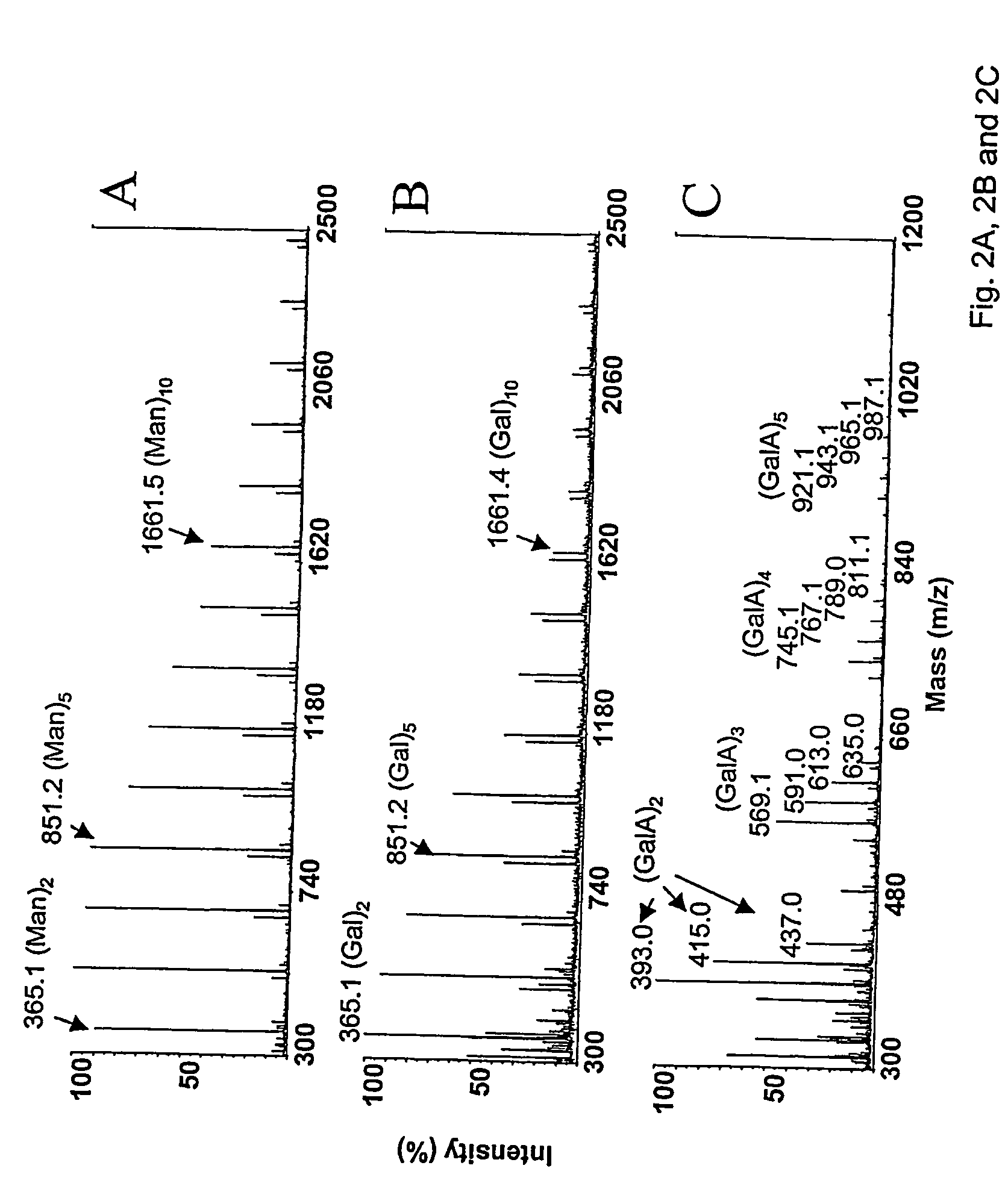Novel carbohydrate compositions and a process of preparing same
- Summary
- Abstract
- Description
- Claims
- Application Information
AI Technical Summary
Problems solved by technology
Method used
Image
Examples
example 1
Single Component Reversions.
[0375] Two pentoses, xylose and arabinose, were subjected to acid reversion with method A. The MALDI-TOF mass spectra of the reaction products reveal in both cases polymers containing up to 18 monosaccharides (FIG. 1). In both cases, dehydration products are observed for each polymeric component (−18 Da).
[0376] Mannose was subjected to reversion for 10 days with method A. The mass spectrum (FIG. 2A) shows polymers exceeding degree-of-polymerization (DP) of 15. Dehydration product is observed for each component. Galactose was reacted for 3 days with method A. Polymers with DP 15 are observed by mass spectrometric analysis (FIG. 2B). It may be noticable that the dehydration products are more pronounced in the galactose reaction than those seen in mannose reversion.
[0377] Galacturonic acid was reacted for 27 days with method A. The lower reactivity of GalA compared to neutral hexoses is obvious as pentamers are the largest polymers obtained (FIG. 2C). Th...
example 2
Reversions of Two Component Mixtures
[0387] 2 mmol of glucose was reversed in a mixture with 0.25 mmol of xylitol with method A for three days. The mass spectrum of the reaction mixture shows both pure glucose polymers as well as species carrying one (but not more) xylitol unit (FIG. 7A). Reacting 1 mmol of glucose with 0.25 mmol of xylitol yielded similar product mass spectrum, but the relative amount of polymers carrying xylitol was higher (not shown).
[0388] Mannose and sorbitol (1:3 molar ratio) were subjected to reversion with method B for 24 h. Under these conditions, all oligomeric species contained sorbitol at the reducing end (FIG. 7B). This was verified by sodium borohydride reduction, which had no effect on the oligomeric species (data not shown). Mannose was reacted with xylitol as well (1:1 molar ratio), using method C. Species containing one xylitol were in great majority (not shown).
[0389] Glucose and sorbitol in 1:1 molar ratio were reacted with method C in nitroge...
example 3
Reversions of Multicomponent Mixtures
[0401] Subjecting several reducing sugars simultaneously to acid reversion offers a possibility to produce a large array of oligosaccharides. The reversion (method B, 45 min) of equimolar mixture of fucose, lactose and N-acetylneuraminic acid shows e.g. trisaccharide species containing one of each reacting monosaccharides (FIG. 10B). In these conditions, only one N-acetylneuraminic acid unit is observed in the products, but it is expected that this ratio can be raised by increasing the molar proportion of N-acetylneuraminic acid in the reaction.
[0402] Reacting an equimolar mixture of fucose, galactose and N-acetylglucosamine with method C yields a large number of products. Part of the tetrasaccharides produced in this reversion are shown as an example in FIG. 12. These species include oligosaccharides carrying all reacting monosaccharides. Production of even more complex products is readily feasible, as exemplified by the reversion of equimola...
PUM
| Property | Measurement | Unit |
|---|---|---|
| Percent by mass | aaaaa | aaaaa |
| Percent by mass | aaaaa | aaaaa |
| Angle | aaaaa | aaaaa |
Abstract
Description
Claims
Application Information
 Login to View More
Login to View More - R&D
- Intellectual Property
- Life Sciences
- Materials
- Tech Scout
- Unparalleled Data Quality
- Higher Quality Content
- 60% Fewer Hallucinations
Browse by: Latest US Patents, China's latest patents, Technical Efficacy Thesaurus, Application Domain, Technology Topic, Popular Technical Reports.
© 2025 PatSnap. All rights reserved.Legal|Privacy policy|Modern Slavery Act Transparency Statement|Sitemap|About US| Contact US: help@patsnap.com



